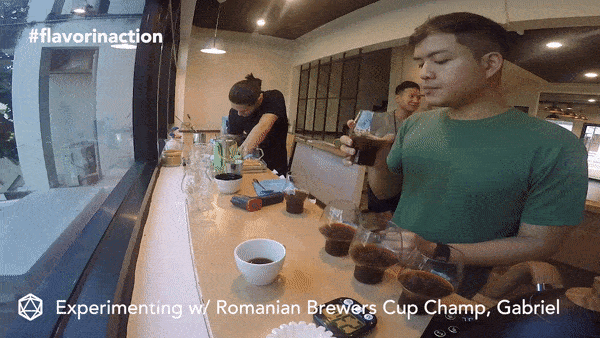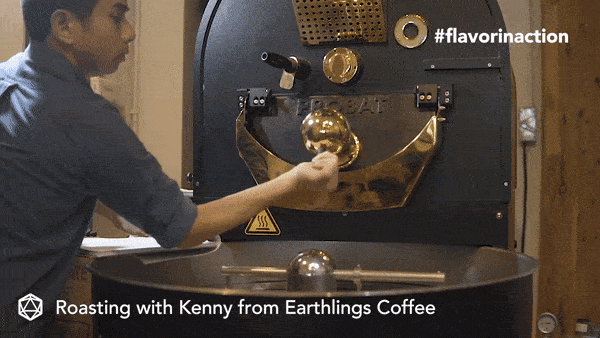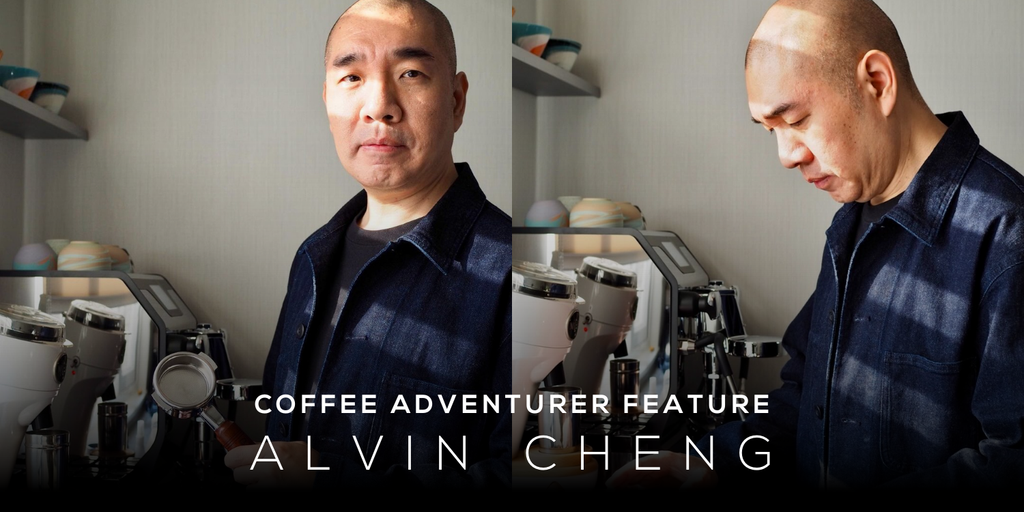
On our journey to develop the AVENSI glassware line (special shaped glasses that elevate the way your coffee tastes), we realized that we had to start at the very root of the problem by asking ourselves ‘what makes coffee taste great?' Behind every problem is a bigger ‘why’, and this is what drove our desire to understand the science behind flavor. In this blog post we dive deep into the science of flavor and how you can apply this knowledge to upgrade your coffee experience.
What is flavor?
I could write an entire essay on how flavor works and how humans interpret it, but I’ll save you the trouble by summarizing it here as best I can.
Flavor can be broken down into 5 elements: Taste, Aroma, Mouthfeel, Vision (your first impression of the food/drink), and Emotion (memories triggered by the flavor that influence your perception).
The three that most people are familiar with are:
(1) Taste (of which there are 5: salty ,bitter, sweet, sour, and umami),
(2) Aroma (of which there are 1 trillion), and
(3) Mouthfeel (think toasted bread vs soggy bread; taste and aroma may be the same, but the texture in your mouth has a profound effect on the flavor).
These three elements of flavor in themselves present a near unlimited combination of flavor profiles, which posed quite the design challenge for us–how can we design a cup that can distinguish and enhance the desirable flavor notes specific to coffee?
Fun Fact: Did you know there are 110 identified flavor, aroma, and texture attributes in coffee?
Coffee the Drink of 1,000,000 Flavors
You’re probably familiar with the factors from cultivation and processing that affect the flavor of your final brew, but did you know that coffee itself is one of the most chemically complex beverages on the planet?
The roasting process alone is a magical craft where expert coffee roasters constantly fine tune and hone the temperature and timing to bring out the best from each coffee bean. But for us, the real fun begins when you consider human biology and how coffee immerses our senses with that familiar aroma and full-bodied flavor.
If you break down the flavor of coffee, it’s evaluated by several factors:
1. Aroma
2. Overall Flavor
3. Aftertaste/Finish
4. Acidity
5. Mouthfeel/Body
6. Balance
7. Sweetness
Pretty complex right?
Let’s look more closely at aroma, acidity, and overall flavor. Coffee scientists and sensory experts have spent the past two decades creating a standardized dictionary of descriptors that allow casual drinkers and experts alike to communicate the diverse flavors in a cup of coffee. These descriptors are often visualized as a wheel (aka ‘flavor wheel’, ‘taste wheel’, or ‘aroma wheel’, depending on which organization you speak with) and break down coffee into primary and secondary flavor notes.
In the tasting wheel below created by Counter Culture Coffee (a leading coffee training, roasting, and retail company), you’ll see the inner ring is where most people start when they describe coffee: “fruity, floral, sweet, chocolaty, etc”. On the secondary and third rings, the tasting notes are broken down further into more specific tasting notes like: nutmeg, citrus, lavender, blueberry–or my personal favorite, marshmallow.
If this is all new to you, coffees that are described with these tasting notes don’t contain nuts, and won’t taste like the citrusy orange juice you get from the grocery store. Your coffee will still taste like it should, but rather there are hints of these tastes and experts use these descriptors to articulate the sensory triggers that come to mind when savoring the coffee’s natural taste.
The beautiful thing about coffee is that if you can taste it, no one can tell you that you’re wrong! If you taste pineapples in your cup–that’s amazing! What a tropically fruity cup you have there. Taste marshmallows? Perhaps your cup will pair nicely with piece of dark chocolate, a fireplace and a warm blanket.
The point is: coffee is as unique as we are–every person is wired differently through their 5 senses to perceive the world differently, and for as many different cups of coffee we can make, there are as many people who will perceive that cup’s flavors differently.
The phrase ‘make your coffee uniquely yours’ couldn’t be more true.
Coffee is an exploratory adventure of the senses and that’s what makes this unassuming drink so magical.
Exploring Infinite Flavors: Our Inspiration

Discovering the rich aromas, diverse tasting notes and depth of flavor in every cup are the inspiration for creating AVENSI, the groundbreaking glassware line that will elevate the way you appreciate coffee. If coffee is the most complex drink on the planet, then why aren’t we enjoying and appreciating it for what it is?
We’re so excited for you try AVENSI, the glassware that will change the way you experience your favorite coffee, and elevate your senses so that you can savor your coffee to the last sip.
Often misunderstood: Flavor vs. Taste vs. Aroma (a quick & simple breakdown)

Flavor, taste and aroma. You’ve heard all these terms before, but what do they really mean? Aren’t taste and flavor the same? I used to think that too, but I was surprised to learn that:
Flavor = Aroma + Taste
This equation is a slight oversimplification of what flavor actually is, but it helps to put things into perspective. Aroma is what you smell through your nose, and taste is what you interpret when the coffee flows over your tongue.
Combined, this gives a very simple understanding of how the flavor of coffee works.
But even considering this simple equation, if you take the 5 tastes that humans can detect (sweetness, sourness, saltiness, bitterness, and umami) and combine it with the 1 trillion different smells that are possible, you can safely assume that there’s nearly an unlimited number of flavors!
Let’s Dig A little Deeper
By definition, flavor is the complete sensory experience that you have when you eat or drink something.
Flavor also includes things like the temperature, aftertaste, whether aromas are orthonasal (smelled through the nose) or retronasal (perceived while you’re chewing or drinking), and texture (aka ‘mouthfeel’).
If you just consider mouthfeel of the food we eat, by comparing toasted bread (😋yum!) with soggy bread (😢ew!), you’ll understand that the way our food or drinks feel on our tongue affects our perception of the flavor.

So how does this relate to coffee? I’m glad you asked!
Just like any other food or beverage, coffee has its own distinct flavor notes that are comprised of several factors we discussed earlier.
The flavor notes in coffee that we’re all familiar with are ‘chocolaty’, ‘nutty’, and ‘bitter’. But as I’m sure you’ve learned by now, coffee is much, MUCH more than that.
If you’re adventurous enough, you can find coffees that smell like jasmine, taste like apricots, and have an aftertaste reminiscent of brown sugar. If you haven’t discovered these flavors for yourself, it’s time to start exploring what’s out there!
Visit your local coffee shop or roaster (Hint: not Starbucks) and find out what special bean and brews they’re roasting up. Coffee is such an expressive beverage and has so much to offer, you just have to go out and find it 😉
Fun Facts about Flavor
1. Just how many unique flavor notes are there in coffee? Coffee has over 850 aromatic and flavor compounds, whereas wine has approximately 200 (we win!). No wonder it’s considered one of the most unique drinks in the world.
2. Coffee flavors are not just dependent on the bean itself. Roasting also plays a big part in how the coffee bean displays its flavors. If you take the same bean, but roast it 3 different ways (light, medium, dark), it will exhibit different aromas and tastes when it’s brewed. [Side note: And of course, the brew method you choose to use (cold brew vs. pour over vs. espresso) the bean will also have a big impact on the flavor of the final brew]
3. Click here to check out this really cool interactive flavor wheel. If you click into each tasting note on the wheel, it will explain how to re-create each of the flavors at home. For example, to understand what “Peach” aroma in coffee smells like, take a Fresh peach pit, put it into a snifter, and cover it. You can also explore other flavor wheels for wine, cheese, and cigars!



